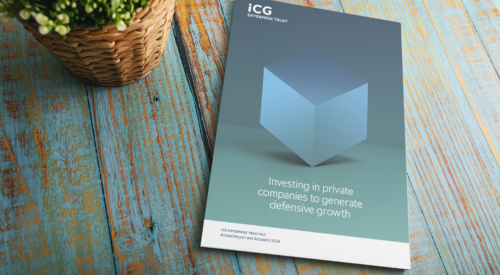Active portfolio construction is an approach to investing in which the investment manager selects, monitors and reviews the portfolio of investments on an ongoing basis and can revise or adjust the portfolio construction based on their current outlook. Active portfolio construction uses human capital to manage or construct an investment portfolio, and is in contrast to a ‘passive’ approach to investment management or portfolio construction whereby, for example, an index of some description is tracked.
Glossary
The vocabulary used by private equity investment trusts is explored within this page. It is presented in A-to-Z format like a dictionary or word index.
- Jump to explanations
Active portfolio construction
Alternative Performance Measures (‘APM’)
Alternative Performance Measures (‘APM’) are a term defined by the European Securities and Markets Authority as ‘financial measures of historical or future performance, financial position, or cash flows, other than a financial measure defined or specified in the applicable financial reporting framework’.
APMs are used if considered by the Board and the Manager to be the most relevant basis for shareholders in assessing the overall performance of ICG Enterprise Trust (‘the Company’) and for comparing the performance of the Company to its peers, taking into account industry practice.
Definitions and reconciliations to international financial reporting standards (IFRS) measures are provided in the main body of our annual report PDFs or in this Glossary, where appropriate.
Buyout
Buyout refers to a transaction in which the buyer acquires a controlling share in the company being sold. This generally results in the majority of equity ownership and voting control being transferred to the buyer.
Carried interest
Carried interest is equivalent to a performance fee. This represents a share of the profits that will accrue to the underlying private equity managers, after achievement of an agreed Preferred Return.
Carrying Value
Carrying Value is the last reported value of an investment, as reported in the investment manager’s valuation report.
Cash drag
Cash drag is the negative impact on performance arising as a result of the allocation of a portion of the entity’s assets to cash.
Co-investment
Co-investment is a Direct Investment in a company alongside a third party, typically a private equity fund.
Co-investment Incentive Scheme
Co-investment Incentive Scheme. ICG and certain of its executives and, in respect of certain historic investments, the executives and connected parties of the Former Manager (together the ‘Co-investors’), are required to co-invest alongside the Company, for which they are entitled to a share of investment profits if certain performance hurdles are met.
Co-investment Incentive Scheme Accrual
Co-investment Incentive Scheme Accrual represents the estimated value of interests in the Co-investment Incentive Scheme operated by the subsidiary partnerships of the Company.
Commitment
Commitment represents the amount of capital that each investor agrees to contribute to a fund or a specific investment.
Deployment
Deployment please see ‘Total new investment’.
Direct Investments
Direct investments (‘Direct’) are investments in a portfolio company that ICG Enterprise Trust holds directly, not through a private equity fund. Direct Investments are typically Co-investments alongside a private equity fund.
- Visit portfolio analysis
Discount
Discount arises when the Company’s shares trade at a price below the Company’s NAV per Share. In this circumstance, the price that an investor pays or receives for a share would be less than the value attributable to it by reference to the underlying assets. The Discount is the difference between the share price and the NAV, expressed as a percentage of the NAV. For example, if the NAV was 100p and the share price was 90p, the Discount would be 10%.
Dividend
Dividend is a distribution of a portion of a Company’s earnings to its shareholders, and is determined by the Company’s board of directors. ICG Enterprise Trust reports its dividends net of all fees, taxes and charges payable by the Company. Investors may incur additional fees, taxes and charges which will reduce their returns.
Drawdowns
Drawdowns are amounts invested by the Company into funds when called by underlying managers in respect of an existing Commitment.
EBITDA
EBITDA stands for earnings before interest, tax, depreciation and amortisation, which is a widely used performance measure in the private equity industry.
Enlarged perimeter
The dataset aggregates underlying company data within each fund included in the sample. The metrics for each underlying company are first value-weighted at the individual fund level, based on the company’s reported value in each fund; the fund level data set is then value-weighted based on the fund’s proportional weighting in the ICGT Portfolio. To avoid double counting, the value of investments in our Top 30 companies is based on their proportional weighting in the ICGT Portfolio, excluding the exposure held through funds included in the fund analysis.
- Visit Portfolio
Enterprise Value (‘EV’)
Enterprise Value (‘EV’) is the aggregate value of a company’s entire issued share capital and Net Debt.
Exclusion List
The Exclusion List defines the business activities which are excluded from investment.
'FY'
‘FY’ is an abbreviation for ‘financial year’ that refers to the 12 month period that aligns to the Company’s financial reporting calendar, which begins on 1 February and ends on 31 January of the following calendar year. The number after ‘FY’ refers to the calendar year in which the financial reporting period.
ICG Enterprise Trust financial reporting periods
Notation |
Reporting period |
Start (day/month) |
End (day/month) |
| FY1 | Financial Year | 1 Feb | 31 Jan |
| Q1 | First quarter | 1 Feb | 30 Apr |
| Q2 | Second quarter | 1 May | 31 Jul |
| H1 | First half | 1 Feb | 31 Jul |
| Q3 | Third quarter | 1 Aug | 31 Oct |
| Q4 | Fourth quarter | 1 Nov | 31 Jan |
| H2 | Second half | 1 Aug | 31 Jan |
1. The numbers after ‘FY’ in a given period reference the calendar year in which ICG Enterprise Trust’s financial year ends.
- Visit Results Centre
FTSE All-Share Index Total Return
FTSE All-Share Index Total Return the change in the level of the FTSE All-Share Index based on the combined return from share price performance and dividends of the index constituents, assuming that dividends are reinvested on the day that they are paid.
ICG Enterprise Trust plc is a constituent of the FTSE250 and the FTSE All-Share Index. The Board considers the FTSE All-Share Index to be the most appropriate comparator for the Company’s shareholders to evaluate the Company’s relative performance.
- Visit financial highlights
Full Exits
Full Exits are realisations or exit events (e.g., trade sale, sale by public offering, or sale to a financial buyer) following which the residual exposure to an underlying company is zero or immaterial.
Fund Disposals
Fund Disposals are where the Company receives sales proceeds from the full or partial sale of a fund position within the secondary market.
General Partner (‘GP’)
General Partner (‘GP’) is the entity managing a private equity fund. This is commonly referred to as the manager.
Half-year (‘H1/H2’)
Half-year (‘H1/H2’) refers to the six-month period that aligns to the Company’s financial reporting calendar, which begins on 1 February and ends on 31 January of the following calendar year. H1 is used to refer to the first six months of the financial year, while H2 refers to the last 6 months of the financial year.
ICG Enterprise Trust financial reporting periods
Notation |
Reporting period |
Start (day/month) |
End (day/month) |
| FY1 | Financial Year | 1 Feb | 31 Jan |
| Q1 | First quarter | 1 Feb | 30 Apr |
| Q2 | Second quarter | 1 May | 31 Jul |
| H1 | First half | 1 Feb | 31 Jul |
| Q3 | Third quarter | 1 Aug | 31 Oct |
| Q4 | Fourth quarter | 1 Nov | 31 Jan |
| H2 | Second half | 1 Aug | 31 Jan |
1. The numbers after ‘FY’ in a given period reference the calendar year in which ICG Enterprise Trust’s financial year ends.
- Visit Results Centre
Hedging
Hedging is an investment technique designed to offset a potential loss on one investment by purchasing a second investment that is expected to perform in the opposite way.
Index
Index tracks the performance of a certain group of stocks, bonds, or other investments. The FTSE All-Share Index represents the performance of all eligible companies listed on the London Stock Exchange’s main market. More information on the FTSE All-Share Index can be found on the FTSE Russell website.
- Visit financial highlights
Initial Public Offering (‘IPO’)
Initial Public Offering (‘IPO’) refers to the process of a private corporation offering shares to the public in a new stock issuance for the first time, by selling its shares on a public stock exchange.
Internal Rate of Return (‘IRR’)
Internal Rate of Return (‘IRR’) is a measure of the rate of return received by an investor in a fund. It is calculated from cash drawn from and returned to the investor, together with the residual value of the investment.
International Securities Identification Number (‘ISIN’)
International Securities Identification Number (‘ISIN’) is a 12 digit alphanumeric code that uniquely identifies a specific security, as recognised by the International Standards Organisation.
Investment Period
Investment Period is the period when a fund to which the Company has made a Commitment is able to make new investments under the terms of the fund agreement. The investment period typically lasts up to five years from the initial Commitment.
Last Twelve Months (‘LTM’)
Last Twelve Months (‘LTM’) refers to the twelve month period up to the end of the current reporting period. LTM figures are included where annualised figures provide the most relevant basis for shareholders in assessing the overall performance of the Company, and for comparing the performance of the Company to its peers, taking into account industry practice.
Limited Partner (‘LP’)
Limited Partner (‘LP’) is an institution or individual who commits capital to a private equity fund established as a Limited Partnership. These funds are generally protected from legal actions and any losses beyond the original investment.
Limited Partnership
Limited Partnership includes one or more General Partners, who have responsibility for managing the business of the partnership and have unlimited liability, and one or more Limited Partners, who do not participate in the operation of the partnership and whose liability is ordinarily capped at their capital and loan contribution to the partnership. In typical fund structures, the General Partner receives a priority share ahead of distributions to Limited Partners.
Local Currency
Local Currency refers, when in relation to an underlying investment in the Portfolio, to the currency in which the investment is originally valued.
Management Fee
Management Fee, refers, when in relation to the Manager, to the fee charged by ICG Alternative Investment Limited, who acts as the Manager for the Company.
Mid-market and larger deals
Mid-market and larger deals is terminology used in private equity to refer to the middle section of the market, by size or value of an investment company. The mid-market excludes small or early-stage companies at the lower end, and very large companies at the upper end.
Multiple to Cost
Multiple to Cost is the average return from Full Exits from the Portfolio in the period, relative to the original cost of those investments. The average is calculated by weighting the multiple to cost of each Full Exit of an investment, by that investment’s proportion of the total original cost of all Full Exits in the relevant period.
- Visit portfolio performance
Net Asset Value (‘NAV’)
Net Asset Value (‘NAV’) represents the total value of the Portfolio and cash on the Company’s balance sheet less Other Net Liabilities (including amounts payable under the Co-investment Incentive Scheme Accrual), sometimes referred to as ‘net assets’.
NAV per Share
NAV per share is the value of the Company’s NAV attributable to one Ordinary share. It is calculated by dividing ‘shareholders’ funds’ by the total number of ordinary shares in issue. Shareholders’ funds are calculated by deducting current and long-term liabilities, and any provision for liabilities and charges, from the Company’s total assets.
NAV per Share Total Return
NAV per Share Total Return is the change in the Company’s Net Asset Value per Share, assuming that dividends are re-invested at the end of the quarter in which the dividend was paid.
Net Debt
Net Debt is calculated as the total short-term and long-term debt in a business, less cash and cash equivalents.
New Investments
New Investments refers to the total of Direct Investments or Co-investments and fund Drawdowns in respect of the Portfolio in a given period.
- Visit portfolio performance
Ongoing Charges
Ongoing Charges are the ongoing charges of the Company calculated in line with the fees and charges reported to investors in the Company’s KID.
- View Key Information Document (KID)
Other Net Liabilities
Other Net Liabilities at the aggregated Company level represent net other liabilities per the Company’s balance sheet. Net other liabilities per the balance sheet of the subsidiaries include amounts payable under the Co-investment Incentive Scheme Accrual.
Overcommitment
Overcommitment refers to where private equity fund investors make Commitments exceeding the amount of cash mmediately available for investment. When determining the appropriate level of Overcommitment, careful consideration needs to be given to the rate at which Commitments might be drawn down, and the rate at which realisations will generate cash from the existing Portfolio to fund new investment.
Partial Exit
Partial Exit is a realisation or exit event (e.g., trade sale, sale by public offering, or sale to a financial buyer) following which ICG Enterprise Trust retains a residual exposure to an underlying company that is not zero nor immaterial.
Portfolio
Portfolio represents the aggregate value of the investments of the Company and of its subsidiary limited partnerships. Unlike the NAV, the Portfolio does not reflect the value of the Co-investment Incentive Scheme Accrual, or any cash or debt retained on the Company’s balance sheet.
- Visit Portfolio
Portfolio Return on a Local Currency Basis
Portfolio Return on a Local Currency Basis represents the change in the valuation of the Portfolio before the impact of currency movements and Co-investment Incentive Scheme Accrual.
Portfolio Company
Portfolio Company refers to an individual company in an investment portfolio.
- Visit top 30 companies
Preferred Return
Preferred Return is the preferential rate of return on an individual investment or a portfolio of investments, which is typically 8% per annum.
Premium
Premium occurs when the share price is higher than the NAV and investors would therefore be paying more than the value attributable to the shares by reference to the underlying assets.
Primary investments
Primary investments are investments held within funds that invest in individual companies. The Company’s Primary Investments may be managed by either ICG or a third-party fund manager. The value of Primary investments within the Company’s Portfolio reflect the total underlying value of investments held within funds, on a lookthrough basis.
- Visit Portfolio analysis
Quarter (‘Q1/Q2/Q3/Q4’)
Quarter (‘Q1/Q2/Q3/Q4’) refers to a three-month period within the year. When used in reference to ICG Enterprise Trust’s reporting periods, this refers to the three-month period that aligns to the Company’s financial reporting calendar, which begins on 1 February and ends on 31 January of the following calendar year.
ICG Enterprise Trust financial reporting periods
Notation |
Reporting period |
Start (day/month) |
End (day/month) |
| FY1 | Financial Year | 1 Feb | 31 Jan |
| Q1 | First quarter | 1 Feb | 30 Apr |
| Q2 | Second quarter | 1 May | 31 Jul |
| H1 | First half | 1 Feb | 31 Jul |
| Q3 | Third quarter | 1 Aug | 31 Oct |
| Q4 | Fourth quarter | 1 Nov | 31 Jan |
| H2 | Second half | 1 Aug | 31 Jan |
1. The numbers after ‘FY’ in a given period reference the calendar year in which ICG Enterprise Trust’s financial year ends.
- Visit Results Centre
Quoted Company
A Quoted Company is any company whose shares are listed or traded on a recognised stock exchange.
Realisation
Realisation is the term used to describe the Full Exit or Partial Exit of an underlying investment.
- Visit Portfolio performance
Realisations - Multiple to Cost
Realisations – Multiple to Cost is the average return from Full Exits from the Portfolio in the period on a primary investment basis, weighted by cost.
Realisation proceeds
Realisation proceeds are amounts received in respect of underlying realisation activity from the Portfolio and exclude any inflows from the sale of fund positions via the secondary market.
- Visit Portfolio performance
Realisations – Uplift To Carrying Value
Realisations – Uplift To Carrying Value is the aggregate uplift on Full exits from the Portfolio in the period excluding publicly listed companies that were exited via sell downs of their shares.
Reported currency
Reported currency refers to the currency in which the Company produces its financial statements and in which it reports its financial data to the public market. ICG Enterprise Trust’s reported currency is British pound sterling (‘GBP’).
Revolving Credit Facility (‘RCF’)
Revolving Credit Facility (‘RCF’) is a type of credit instrument used by the Company which can be drawn (in full or in part) and repaid (in full or in part) over the term of the facility. An RCF is made available up to a maximum amount and up to an agreed maturity date.
Secondary investments
Secondary investments refers to the underlying Portfolio value of assets acquired in the Secondary market, which may be held through funds which focus on investing in the Secondary market.
One function of the Secondary market is enable an LP to sell their interest in an existing private equity fund, including any associated Commitments, to another investor, such as the Company, or the manager of a Secondary-focused fund.
- Visit portfolio analysis
Share buyback
Share buybacks, or stock repurchases, occur when a company uses its own funds to buy its outstanding shares in the open market, thereby reducing the number of shares in circulation. As a result of buybacks, existing shareholders own a greater percentage of the company’s assets and profits.
If share buybacks are executed at a discount to NAV, the buyback will increase the NAV per Share of the remaining shares outstanding.
Share Price Total Return
Share Price Total Return is the change in the Company’s share price, assuming that dividends are re- invested on the day that they are paid.
Shares in issue
Shares in issue refers to the total number of equity shares issued by the Company. This includes shares held by investors and those held in reserve for employee compensation, and excludes shares held in treasury by the Company.
- Visit Regulatory News Service (RNS) and search for Voting Rights and Capital
Stock Exchange Daily Official List (‘SEDOL’)
Stock Exchange Daily Official List (‘SEDOL’) is a seven-character identification code assigned to securities that trade on the London Stock Exchange and certain other smaller exchanges in the United Kingdom.
Ticker
Ticker is a unique series of letters assigned to a security to as an individual identifier for trading purposes, referencing the name of the security and the stock exchange on which it is traded. The ticker for ICG Enterprise Trust is ICGT: LN.
- Visit Investors
Total New Investment
Total New Investment is the total of direct Co-investment and fund investment Drawdowns in respect of the Portfolio. In accordance with IFRS 10, the Company’s subsidiaries are deemed to be investment entities and are included in subsidiary investments within the financial statements.
- Visit Portfolio performance
Total Proceeds
Total Proceeds are amounts received by the Company in respect of the Portfolio, which may be in the form of capital proceeds or income such as interest or dividends. In accordance with IFRS 10, the Company’s subsidiaries are deemed to be investment entities and are included in subsidiary investments within the financial statements.
Total Return
Total Return is a performance measure that assumes the notional re-investment of dividends. This is a measure commonly used by the listed private equity sector and listed companies in general.
Undrawn Commitments
Undrawn Commitments are Commitments that have not yet been drawn down (please see ‘Drawdowns’).
Unquoted Company
An Unquoted Company is any company whose shares are not listed or traded on a recognised stock exchange.
Uplift To Carrying Value
Uplift to Carrying Value is the increase in value from Full Exits, excluding publicly listed investments, based on the agreed valuation at time of sale as compared to the last reported valuation of those investments.
Uplift to Carrying Value is calculated as the average of the increase in value from each Full Exit in the period weighted by that investment’s proportion of the total increase in value of Full Exits during the relevant period.
- Visit portfolio performance
Valuation Date
The date of the valuation report issued by the underlying manager.
Valuation Multiples
Valuation Multiples are earnings (EBITDA), or revenue multiples applied in determining the value of a business enterprise.




















 Back
Back